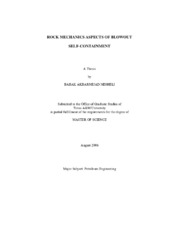| dc.description.abstract | A blowout is an uncontrolled flow of reservoir fluids into the wellbore to the surface,
causing serious, sometimes catastrophic, problems in different types of petroleum
engineering operations. If the formation's strength is low and the pore pressure is high,
bridging can be a very effective method for blowout containment. In this method, the
formation caves into the open hole or onto the casing and stops the flow of the
formation's fluid, either naturally or intentionally. This method can be effective in
deepwater blowouts where the formation has high pore pressure and considerable shale
intervals with low strength.
In this research, wellbore stability and fluid flow performance subroutines have
been developed with Visual Basic for Applications (VBA) programming. By integrating
the subroutines together, we made a simulation tool to predict wellbore stability during
blowouts and, consequently, predict wellbore bridging during normal and blowout
situations. Then we used a real case in the country of Brunei to investigate a field case of
a bridged wellbore to validate the simulator. In addition to the field case, we used GMI
SFIB 5.02, a wellbore stability software, to provide validation.
In the final part of this research we studied the effect of water depth in bridging
tendency during blowout for the deepwater Gulf of Mexico (GOM). Since we could not
find any real data in this area, we used general trends and correlations related to the
GOM. The results of our study showed that water depth delays the occurrences of
breakout in the wellbore during blowouts (i.e. for greater depth of water, wellbore collapse occurs farther below the mudline). However, the depth in which collapse occurs
is different for different maximum horizontal stress amounts. | en |


